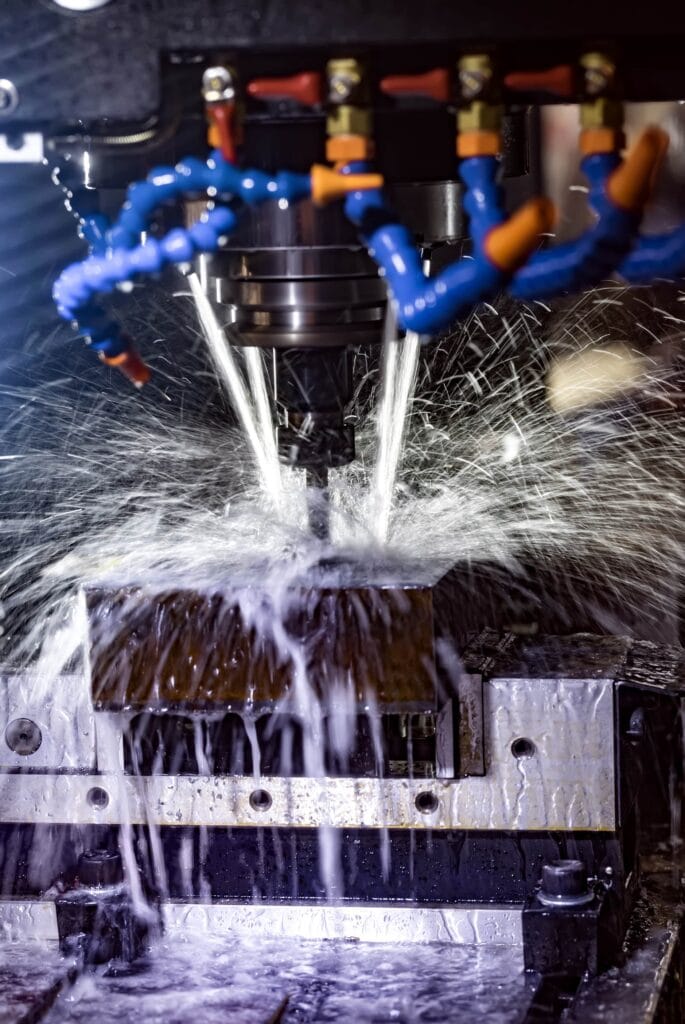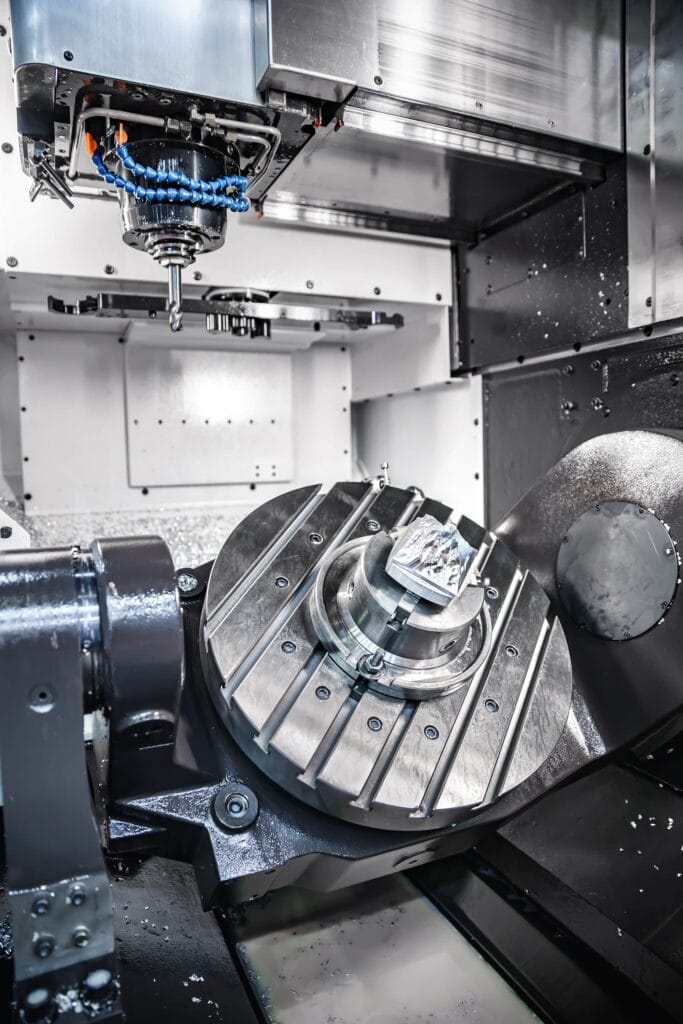CNC machining is an accurate and streamlined way to traditionally machine complicated parts. Did you know that some CNC machines are even more accurate and can handle more complex parts than others? It all boils down to how many axes they have. In this piece, we’ll teach you the difference between 3, 4, and 5-axis machining and which one is right for your application.
What is an Axis in Machining?
If you think back to your math days in school, you might remember what an axis is. Basically, it’s used to describe motion along a given path.
For example, a regular chart usually has an x and y-axis. If you plot how much money you spend on beer over time, you’ll be using something like this. Time moves with the x-axis, and beer money spend moves with the y-axis.
This same idea can be used on a CNC (computer numerical control) machine. CNC machines use computer software to control the motion of cutting tools around a part. In the old days, machinists would have to manually jog a machine and measure all the features by hand before cutting.
If you look at a CNC mill going to the left and right, we would call that the x-axis on the machine. Typically, motion to the left would be in the negative direction, and motion to the right is in the positive direction.
When Do the Axes Matter?
The axes are among the most important part of running a CNC machine. They are used in every single hole, cut, and feature that gets machined.
In fact, the first step of most projects is to “zero” the axes. This is a process of telling the machine where the material is to get the most accurate final product.
So, we established how vital axes are. The next step is to explain the difference between machines with 3, 4, and 5 axes.
What is 3-Axis CNC Machining?
3-axis machines are a more traditional style of CNC mac
They’re also more commonly found on the shop floor and are the least intricate option on this list.
They can move left-to-right (x-axis), front-to-back (y-axis), and up and down (z-axis). Combining these three axes gives you the XYZ plane.
3-axis is the only style of machine on this list in which the material is stationary for the cutting operation. You clamp raw material into a vise and move the cutting head around it.
Although this is the simplest form of machining on this list, it’s still highly complex. The programming allows a skilled machinist to make some intricate parts as long as they know what they’re doing.
Uses for a 3-Axis Machine
-Drilling holes
-Machining slots
-Rounding corners
-Cutting simpler features and geometries
What is 4-Axis CNC Machining?
Slap on another axis, and you get a 4-axis machine. In this case, you’re adding the A-axis. The A-axis rotates around the x-axis of the machine. Rotation away from the operator is considered the positive direction.
In most 4-axis CNC machines, the workpiece will be the part that rotates in the A-axis. In other words, the material that you clamped down can actually rotate while the machine is operating.
The impressive part of this added axis is that it can move in junction with other axes. The CNC machine can rotate a piece while drilling a slot, for instance.
This allows for much more complex parts to be made. The orchestration between the XYZA axes is fun to watch.
Uses for a 4-Axis Machine
-Cutting features on cylindrical or curved pieces
-Working along the side of material without manually rotating and re-zeroing the machine
-Continuous cutting
-Making multi-axis rounded features
What is 5-Axis CNC Machining?

The final, and most complicated form of CNC machines on our list is the 5-axis machine. The added 5th axis can differ from machine to machine:
-Around the x-axis is the A-axis
-Around the y-axis is the B-axis
-Around the z-axis is the C-axis
A machine might offer XYZAB, XYZAC, or XYZBC. Most often, machines offer an XYZAB configuration.
Just like in 4-axis machining, the workpiece is typically the area that moves in these two extra axes.
As you can imagine, this allows for even more complicated parts to be made. It also allows for a fully autonomous process — the machinist doesn’t have to take a part out of the vise, rotate it, and put it back in since the cutting tool will move all around the piece.
This ultimately leads to quicker operational time.
Uses for a 5-Axis Machine
-High-accuracy pieces
-Faster turnarounds
-Making intricate parts
-Machining complex geometries and features
-Less operator interaction
Which Is the Best CNC Machine Option?
To better understand which CNC machine option is right for your project, take a look at this list of considerations to make.
Complexity of Parts
When it comes to the additional 4th and 5th axes, machining parts becomes simpler, and objects can be more complex. Since the tool can now rotate multiple ways, non-symmetric and rounded features can be added to square parts. You can even add compound angles to standard drilled and tapped holes.
A lot of times, tolerances will become tighter with CNC machines that have more axes. This further improves how complicated you can design a part to be with the understanding that it will still work in your application and fit in your assembly.
Benefits of Hands-Off Machining
There is certainly a lot of automation that comes in a standard 3-axis CNC machine. The downside is that the machinist will have to change the orientation of the part and might have to spend time setting up the angle of the head to make complicated features.
With 4-axis and especially 5-axis CNC machines, it’s more hands-off. Since the heads can move around freely and more than a standard machine, it’s common for a machinist to set up the program and let the machine do the rest of the work.
With foresight into how to hold the part before starting the cut, it’s possible that the machinist doesn’t need to re-orient the part at all.
Project Timeline
The other difference as you add more axes is how quickly the project gets done. CNC options are still dramatically faster than manual milling, but 5-axis tools usually finish projects faster than 3-axis ones.
This has to do with the faster operation, less need for machinist intervention, and the ability to make complex features without additional setup.
Shop Capabilities
If you want to use a 4-axis or 5-axis machine for your upcoming project, you’ll need to do some research. Finding a shop that offers these more complicated CNC machines is more difficult than you might think.
Smaller shops might only have 3-axis CNC machines on their floor. Alternatively, their 5-axis tools might only be reserved for their top customers who have the largest orders. Rapid Axis utilizes equipment with 3, 4 and 5-axis capabilities.
Added Cost for Premium Services
Some machine shops charge more for using their 4-axis and 5-axis CNC machines. This might be considered a premium offering for a shop, so it makes sense that the price is higher. Not to mention these tools cost significantly more than a standard 3-axis mill.
Make sure you reach out to the shop ahead of time to get a budgetary quote before deciding on which shop is right for you. Ideally, you would find a shop that offers 5-axis CNC machining without charging you extra or forcing you to place a massive order.
Conclusion
We just covered everything you need to know about the differences between 3-axis, 4-axis, and 5-axis CNC machines along with which option is right for you. 5-axis machines are more expensive and a little tougher to find, but they offer the fastest turnaround times and can handle the most complex parts.
At Rapid Axis, we have a number of 3-axis, 4-axis, and 5-axis CNC machines at our disposal to handle your projects. We don’t charge a premium upcharge or make it inconvenient for you. Reach out to us today to get a free quote or chat with one of our expert machinists.
